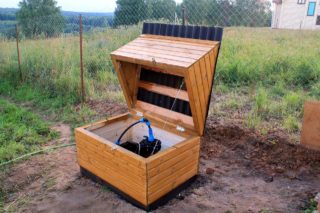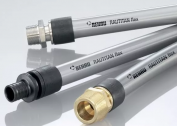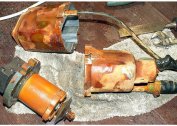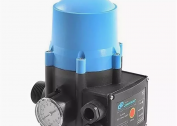In order for an autonomous source to work smoothly at any time of the year, it is important to take care of high-quality insulation of the well and the water supply in a private house for the winter. This can be done at the stage of construction of the system or already with it on the site.
Why is a well warming necessary?
To insulate the source itself and the pipes going from it to the house, it is necessary for the following reasons:
- At subzero temperatures and an improperly arranged system, the water mirror in the well is covered with ice. As a result, a column of water located above the level of soil freezing is also prone to the formation of ice plugs. This leads to obstructed fluid supply to the line.
- When ice plugs form, water pipes or casing can break, which will require further expensive repairs.
- Equipment operating in conditions of icing and increased loads threatens with failure. Gusts of cranes, malfunction of the pump - all these are serious breakdowns. Especially in the winter.
More often, ice plugs are formed during irregular operation of the well with downtime. During these periods, the surface of the water column is already prone to crystallization. But even if the owners of the source do not assume downtime in the operation of the water supply system, for the purpose of prevention, it is worthwhile to insulate all external mains networks located above the level of soil freezing.
Insulation works are carried out from the point of entry of the pipeline into the house to the depth of the casing, which is already 20-30 cm below the level of soil freezing in a particular region.
Insulation Requirements
Thermal insulation materials used when working with water supply networks must meet the following requirements:
- Good moisture resistance. The moisture-absorbing insulation will turn into an ice casing, which will crumble over time.
- Lack of deformation under the influence of static and dynamic loads. Even calm soil periodically presses on the pipes of the system, increasing its mass under the influence of atmospheric precipitation, and a person walking along the site.
- Low thermal conductivity.
- Minimal interest for rodents and other local animals. Small animals can nibble solid heaters, form tunnels in them in an attempt to get to warm pipes. Such bridges of cold negate all the efforts of the master to warm the system.
It is necessary to select the insulation material depending on the budget of the master, the features of the temperature regime in the region.
Tools and materials
To properly insulate the well from the street, it is necessary to prepare the following tools:
- roulette;
- construction tape and pencil;
- hacksaw for cutting insulation;
- liquid nails, self-tapping screws for attaching sheets of material to the caisson frame;
- shovel.
Additionally, the insulation itself should be prepared. More often use such materials:
- Glass wool or mineral wool. Cheapest options. Prone to deformation and drink moisture. To use such insulation, you will have to create an additional protective durable casing on top of the materials. Use cotton only in places where condensation or leaks are excluded. It is forbidden to use these types of heaters provided that the groundwater is high on the site.
- Basalt fiber. Due to the foil coating, the material is considered convenient in use, having good thermal insulation characteristics.
- Styrofoam or Styrofoam. It can be used in the form of sheets or special cylinders. Both types of material are easy to cut, retain heat very well, but are of interest to rodents.When using foam insulation, you need to make a special protective coating of cement and broken glass.
- Sprayed polyurethane foam. Easy to use. When using it, water pipes must be laid on expanded clay backfill.
- Thermal paint. A liquid heat insulator is expensive, but with it you can process the most inaccessible sections of the highway and equipment. If the paint is used on metal parts, it additionally serves as a corrosion protection.
A good solution is a heating cable. It maintains a stable temperature in the highway even in severe frosts.
The main methods of insulation
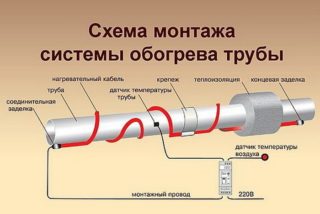 For proper heating of the water supply system from the side of the street, it is necessary to work comprehensively, protecting the trunk, caisson and the upper part of the casing. You need to start with it. The work is performed as follows:
For proper heating of the water supply system from the side of the street, it is necessary to work comprehensively, protecting the trunk, caisson and the upper part of the casing. You need to start with it. The work is performed as follows:
- Dig a pipe to a depth below the level of freezing of the soil (about 20-30 cm). This also applies to the Abyssinian well in the country, if it is operated in winter.
- The pipe is sheathed with a fine-mesh metal mesh.
- A strong casing is installed around the column so that a gap of 5-10 cm remains between it and the pipe.
- In the free space, the selected insulation is poured / laid. He is not rammed.
In the upper part of the well, where the outlet hoses are already located, mount a tray under them. It should go beyond the casing so that condensation or moisture flowing down the metal elements does not get on the insulation.
Caisson insulation
A caisson is a protective chamber over the casing head. A hydraulic accumulator and automatic equipment for pumping equipment are installed here. Caisson protects the top of the well from precipitation, debris. So that it also serves as protection from the cold, it is important to insulate it around the entire perimeter. You can do this outside or inside the camera. Regardless of the shape of the caisson (round, square, rectangular), it is necessary to sheathe it with a heater around the entire perimeter.
The insulation of the caisson can be performed according to the principle of working with the casing - make another casing for the camera (internal or external). After its installation, the space between the two partitions is filled with insulation.
The caisson cover must be treated with heat-insulating paint or other materials convenient for the master.
Pipeline insulation
This part of the system is treated with special care, especially if the tubes lie above the level of freezing of the soil. The best option for insulation is cylindrical polystyrene shells, which are simply worn on the trunk. They are joined, the seams are oiled with glue and pressed tightly for a while. It is important that the transverse joints of the insulation are offset with respect to each other. Then the bridges of cold will be much less.
Another way to insulate pipes is to use a heating cable. It is wound on the trunk from the entrance to the house to the input into the casing. Previously, foil is wound on the tubes. Then, with the help of construction tape, a heating cable is mounted in a spiral. The turn pitch should be the smaller, the larger the cross section of the trunk. On top of the heating cable cover another layer of foil. Such a heater is included in the network with a stable drop in air temperature to -5 degrees.
If the input pipe to the house is laid below 1 m, then its insulation is not required for the southern and central stripes of Russia.
